Assessing the Importance of the Marine Chokepoint: Evidence from Tracking the Global Marine Traffic
Abstract
:1. Introduction
2. The Literature Review
3. Data and Methodology
3.1. Data
3.2. Identification of Maritime Trajectories and Strategic Chokepoints
3.3. Maritime Transport Dependency
4. Empirical Results
4.1. Global Maritime Transport Flows Pattern
4.1.1. Spatial and Temporal Variation in Global Maritime Transport Flows
4.1.2. Variability of Maritime Traffic Flow in Priority Regions
4.2. Critical Chokepoints Identification
4.3. Chokepoints Scope of Influence
4.3.1. Overall Supply–Demand Influence
4.3.2. The Chokepoint’s Maritime Sphere of Influence
4.4. Discussion
5. Conclusions and Policy Implications
Author Contributions
Funding
Institutional Review Board Statement
Informed Consent Statement
Data Availability Statement
Conflicts of Interest
References
- Le Billon, P. The geopolitical economy of ‘resource wars’. Geopolitics 2004, 9, 1–28. [Google Scholar] [CrossRef]
- UNCTAD. Review of Maritime Transport 2022. Available online: https://unctad.org/rmt2022 (accessed on 1 July 2023).
- Ma, M.; Fan, H.; Jiang, X.; Guo, Z. Truck arrivals scheduling with vessel dependent time windows to reduce carbon emissions. Sustainability 2019, 11, 6410. [Google Scholar] [CrossRef]
- Xiao, L.; Chen, S.; Xiong, S.; Qi, P.; Wang, T.; Gong, Y.; Liu, N. Security risk assessment and visualization study of key nodes of sea lanes: Case studies on the Tsugaru Strait and the Makassar Strait. Nat. Hazards 2022, 114, 2657–2681. [Google Scholar] [CrossRef] [PubMed]
- Rodrigue, J.P. Straits, passages and chokepoints: A maritime geostrategy of petroleum distribution. Cah. Géographie Québec 2004, 48, 357–374. [Google Scholar] [CrossRef]
- Titovich, A.; Atnashev, V. Development Trends of the Strait of Malacca Countries in the Field of Countering Non-traditional Threats to National Security in the Context of the Indo-Pacific Region in 2010s–2020s. In Proceedings of Topical Issues in International Political Geography; Springer Geography; Springer: Cham, Switzerland, 2021. [Google Scholar] [CrossRef]
- McIntyre, W.D. The Strategic Significance of Singapore, 1917–1942. The Naval Base and the Commonwealth. J. Southeast Asian Hist. 1969, 10, 69–94. [Google Scholar] [CrossRef]
- Chua, D.W.B. America’s Role in the Five Power Defence Arrangements: Anglo-American Power Transition in South-East Asia, 1967–1971. Int. Hist. Rev. 2017, 39, 615–637. [Google Scholar] [CrossRef]
- Jiang, M.; Lu, J. A novel risk assessment approach for strait/canal security evaluation along the 21st Century Maritime Silk Road. Int. J. Shipp. Transp. Logist. 2022, 15, 215–238. [Google Scholar] [CrossRef]
- Fan, H.; Gong, X.; Lyu, J. Resilience assessment of strait/canal: A rule-based Bayesian network framework. Transp. Res. Part D Transp. Environ. 2023, 12, 103960. [Google Scholar] [CrossRef]
- Shepard, J.U.; Pratson, L.F. Maritime piracy in the Strait of Hormuz and implications of energy export security. Energy Policy 2020, 140, 111379. [Google Scholar] [CrossRef]
- Zuhdi, A.; Turan, E. Kra canal project and its influence on world maritime trade. Proc. Inst. Mech. Eng. Part M J. Eng. Marit. Environ. 2022, 236, 493–503. [Google Scholar] [CrossRef]
- Parlow, A. Arctic Geopolitics, Cross-Boundary Soft-Power, Ecosystem Protection, and Human Security in the Bering Sea and Strait. In The Climate-Conflict-Displacement Nexus from a Human Security Perspective; Springer International Publishing: Cham, Switzerland, 2022; pp. 171–196. [Google Scholar]
- Peters, K. Deep routeing and the making of ‘maritime motorways’: Beyond surficial geographies of connection for governing global shipping. Geopolitics 2020, 25, 43–64. [Google Scholar] [CrossRef]
- Waloven, S.; Kapsar, K.; Schwoerer, T.; Berman, M.; Schmidt, J.I.; Viña, A.; Liu, J. Global gateways as telecoupled human and natural systems: The emerging case of the Bering Strait. AMBIO 2023, 52, 1040–1055. [Google Scholar] [CrossRef] [PubMed]
- Pratson, L.F. Assessing impacts to maritime shipping from marine chokepoint closures. Commun. Transp. Res. 2023, 3, 100083. [Google Scholar] [CrossRef]
- Qu, X.; Meng, Q. The economic importance of the Straits of Malacca and Singapore: An extreme-scenario analysis. Transp. Res. Part E Logist. Transp. Rev. 2012, 48, 258–265. [Google Scholar] [CrossRef]
- Carral, L.; Tarrío-Saavedra, J.; Crespo-Pereira, D.; Fernández-Campoamor, M.; Sabonge, R. Competitive position of the expanded Panama Canal in the shipment of liquefied natural gas. Proc. Inst. Mech. Eng. Part M J. Eng. Marit. Environ. 2019, 233, 1154–1176. [Google Scholar] [CrossRef]
- Komiss, W.; Huntzinger, L. The Economic Implications of Disruptions to Maritime Oil Chokepoints; Center for Naval Analysis: Alexandria, VA, USA, 2011. [Google Scholar]
- Liu, Z.; Wu, Z.; Zheng, Z.; Yu, X. A Molecular Dynamics Approach to Identify the Marine Traffic Complexity in a Waterway. J. Mar. Sci. Eng. 2022, 10, 1678. [Google Scholar] [CrossRef]
- Wu, L.; Xu, Y.; Wang, Q.; Wang, F.; Xu, Z. Mapping global shipping density from AIS data. J. Navig. 2017, 70, 67–81. [Google Scholar] [CrossRef]
- Bateman, S.; Ho, J.; Mathai, M. Shipping Patterns in the Malacca and Singapore Straits: An Assessment of the Risks to Different Types of Vessel. Contemp. Southeast Asia 2007, 29, 309–332. [Google Scholar] [CrossRef]
- Maimun, A.; Nursyirman, I.F.; Sian, A.Y.; Samad, R.; Oladokun, S. Using AIS data for navigational risk assessment in restricted waters. In Transportation Systems and Engineering: Concepts, Methodologies, Tools, and Applications; IGI Global: Hershey, PA, USA, 2015; pp. 1154–1163. [Google Scholar]
- Billings, S.B.; Johnson, E.B. The location quotient as an estimator of industrial concentration. Reg. Sci. Urban Econ. 2012, 42, 642–647. [Google Scholar] [CrossRef]
- Panagiotopoulos, G.; Kaliampakos, D. Location quotient-based travel costs for determining accessibility changes. J. Transp. Geogr. 2021, 91, 102951. [Google Scholar] [CrossRef]
- Ma, W.; Qian, Z.S. Estimating multi-year 24/7 origin-destination demand using high-granular multi-source traffic data. Transp. Res. Part C Emerg. Technol. 2018, 96, 96–121. [Google Scholar] [CrossRef]
- Sobral, T.; Galvão, T.; Borges, J. Visualization of urban mobility data from intelligent transportation systems. Sensors 2019, 19, 332. [Google Scholar] [CrossRef] [PubMed]

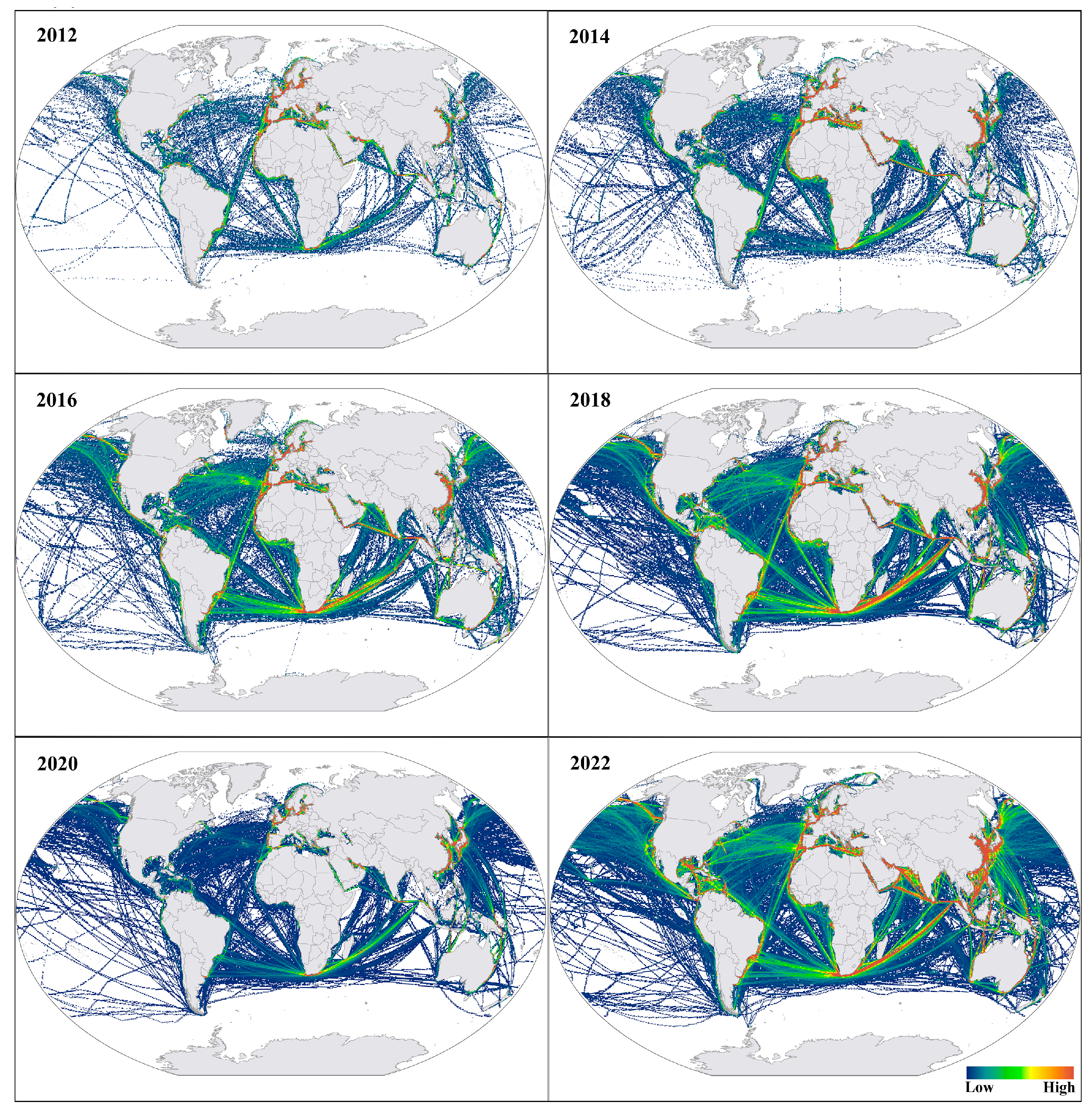
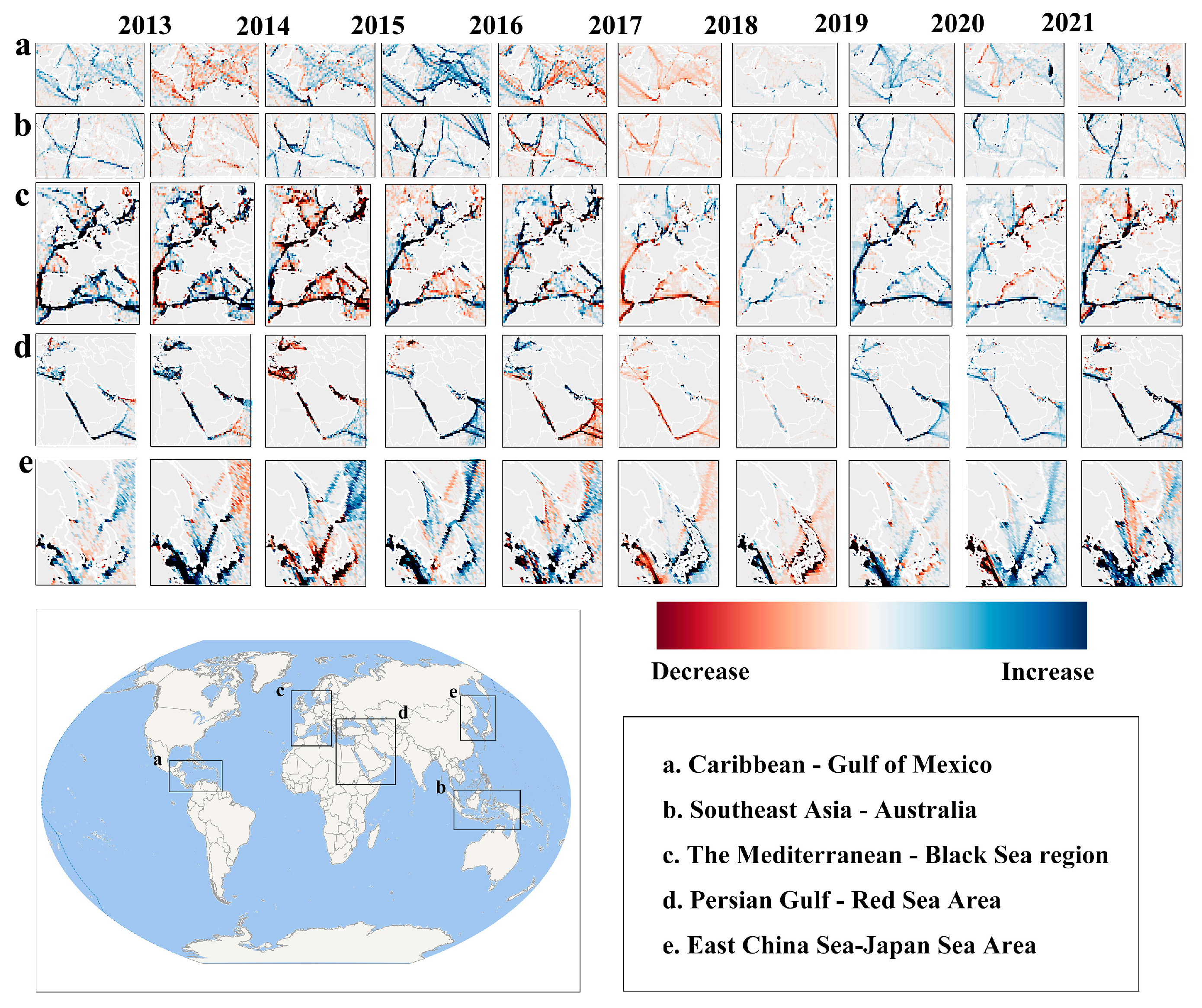


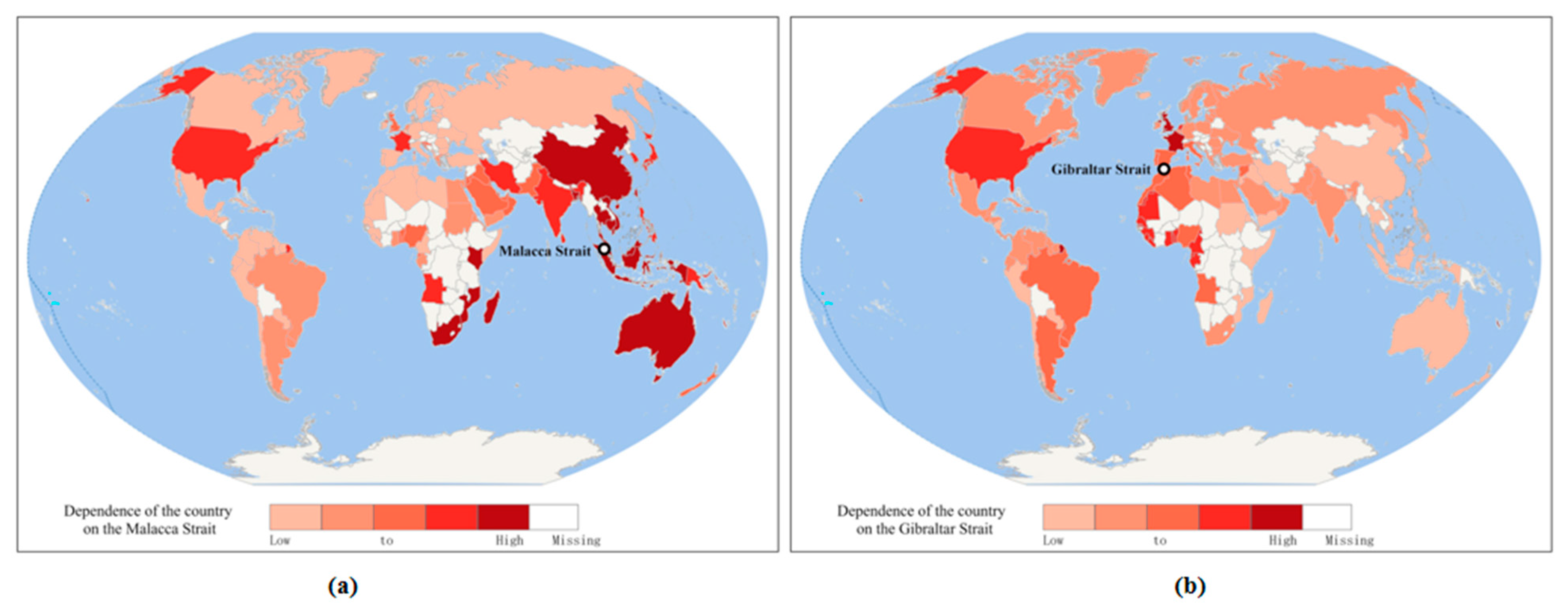

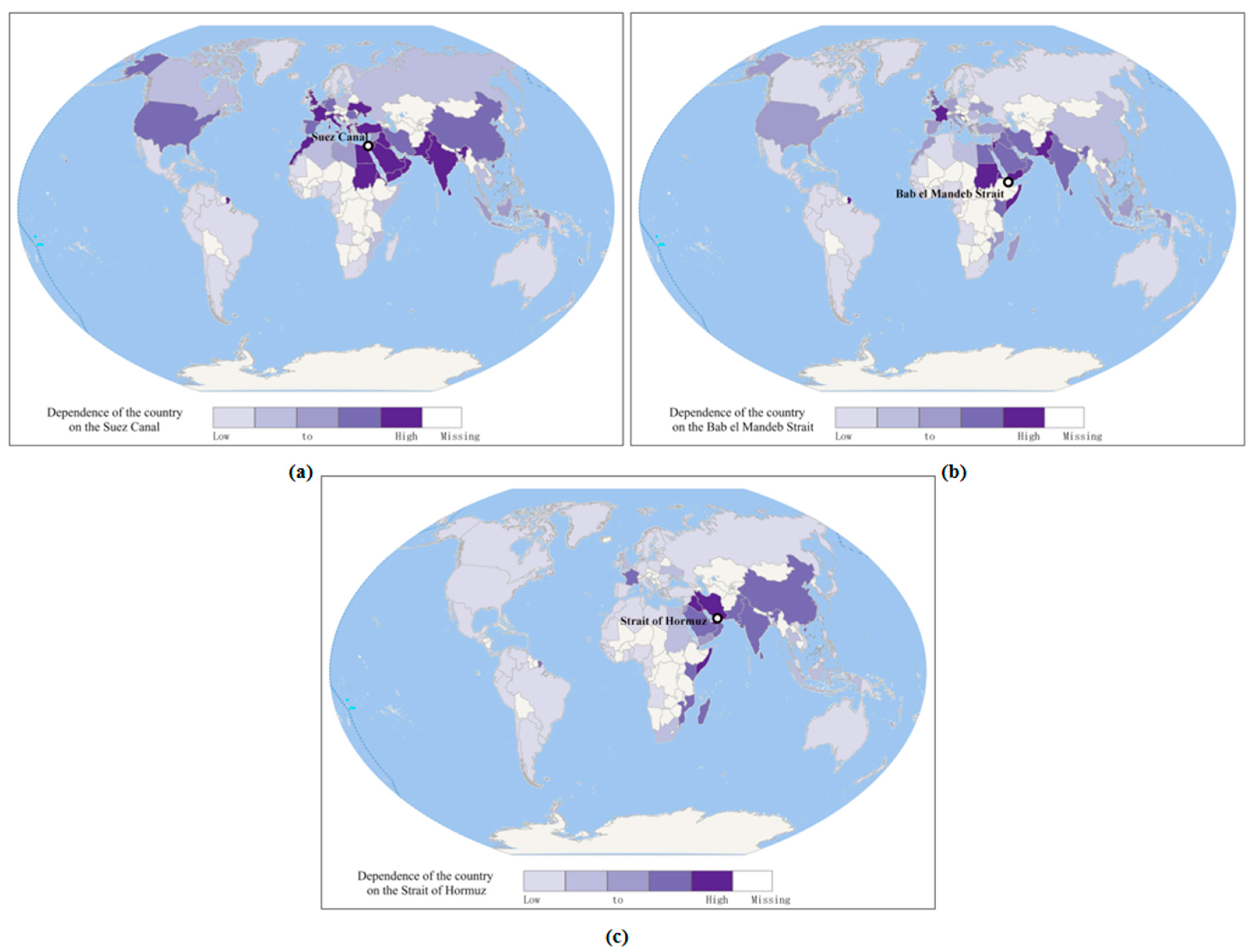
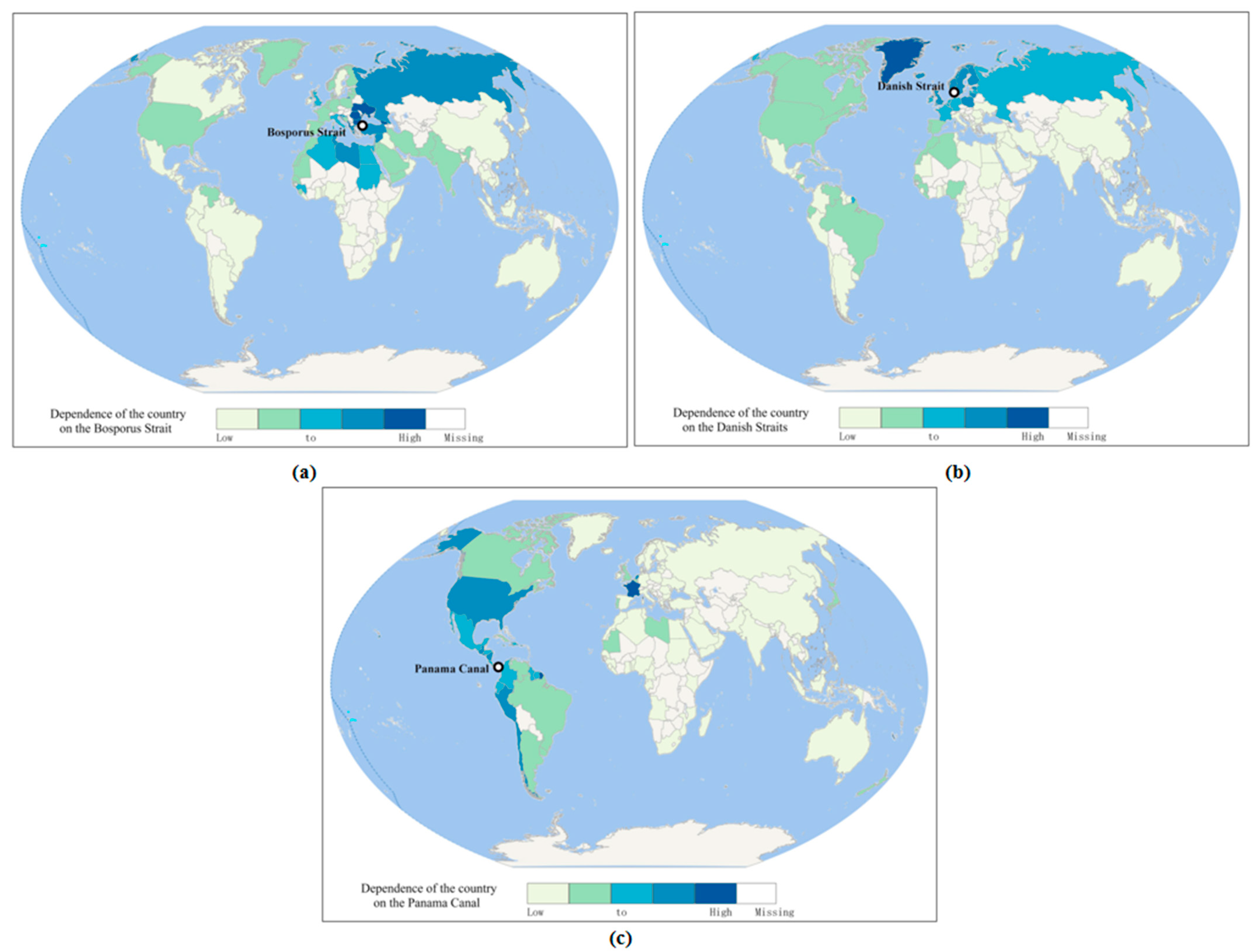
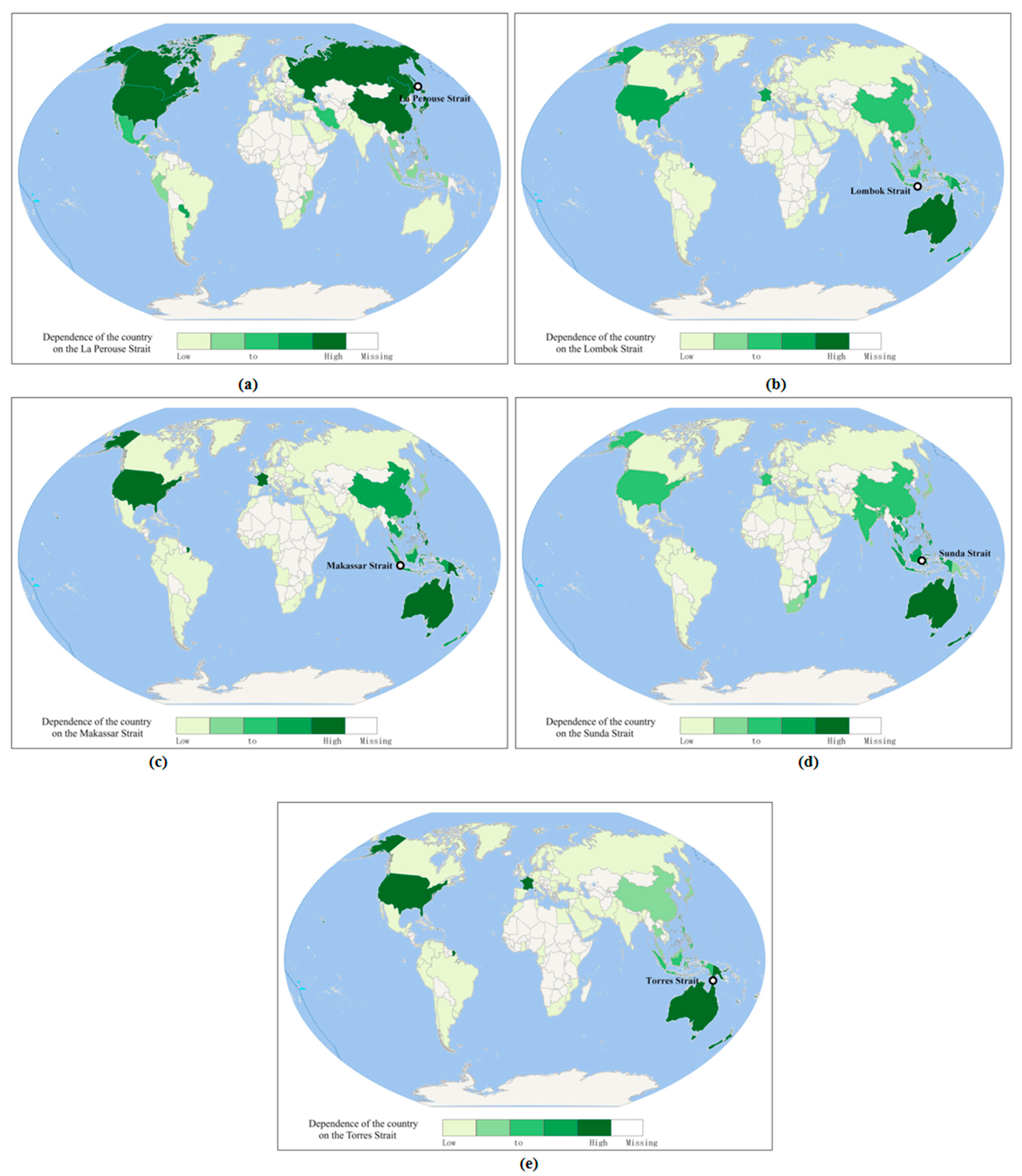
Disclaimer/Publisher’s Note: The statements, opinions and data contained in all publications are solely those of the individual author(s) and contributor(s) and not of MDPI and/or the editor(s). MDPI and/or the editor(s) disclaim responsibility for any injury to people or property resulting from any ideas, methods, instructions or products referred to in the content. |
© 2023 by the authors. Licensee MDPI, Basel, Switzerland. This article is an open access article distributed under the terms and conditions of the Creative Commons Attribution (CC BY) license (https://creativecommons.org/licenses/by/4.0/).
Share and Cite
Wang, X.; Du, D.; Peng, Y. Assessing the Importance of the Marine Chokepoint: Evidence from Tracking the Global Marine Traffic. Sustainability 2024, 16, 384. https://doi.org/10.3390/su16010384
Wang X, Du D, Peng Y. Assessing the Importance of the Marine Chokepoint: Evidence from Tracking the Global Marine Traffic. Sustainability. 2024; 16(1):384. https://doi.org/10.3390/su16010384
Chicago/Turabian StyleWang, Xue, Debin Du, and Yan Peng. 2024. "Assessing the Importance of the Marine Chokepoint: Evidence from Tracking the Global Marine Traffic" Sustainability 16, no. 1: 384. https://doi.org/10.3390/su16010384
APA StyleWang, X., Du, D., & Peng, Y. (2024). Assessing the Importance of the Marine Chokepoint: Evidence from Tracking the Global Marine Traffic. Sustainability, 16(1), 384. https://doi.org/10.3390/su16010384




